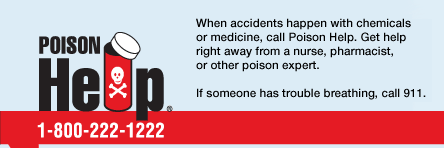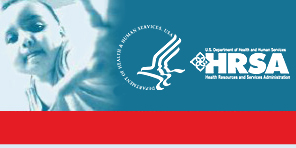

 |

|
On This Page:
Support National Poison Prevention Week, March 16-22, 2008To kick-off National Poison Prevention Week, HRSA unveiled a new digital Poison Help Campaign (PoisonHelp.hrsa.gov) at an event in Union Station in Washington, DC on Thursday, March 13 from 9am-6pm. The event, in conjunction with the Poison Prevention Week Council, featured exhibitors from partner organizations who distributed materials and answered questions about poison prevention. There was a press event at 11am where Dr. Elizabeth Duke, HRSA Administrator, highlighted the increased trends in poisonings, the need for continued prevention efforts and the resources available at the nation’s poison control centers. Also delivering remarks at the press event were Nancy Nord, Acting Chairman for Consumer Products Safety Commission, and Dr. Stuart Heard, President of the American Association of Poison Control Centers, along with Nancy Bock and Kristin Lolmaugh of the Poison Prevention Week Council. Be a part of your community efforts during National Poison Prevention Week! Contact the Poison Control Center in your area to learn about activities being conducted in your area to educate the public about poison prevention. Poison Help Campaign LaunchHRSA Poison Control Program has launched the new Poison Help Campaign and Web site, PoisonHelp.hrsa.gov. The focus of the Campaign is to serve as a resource for poison prevention information and inform Americans about the national Poison Help toll-free number (1-800-222-1222) for expert advice on poisoning. On the site are educational materials, including downloadable brochures, tip sheets, and digital ads. In addition, visitors to the site can learn the 1-800-222-1222 jingle in English and Spanish! The Web site links to each poison control center and provides other poison information resources. Poison Control Centers: A Prescription for Value - 2008 Poison Control Program Grantee MeetingThe HRSA Poison Control
Program (PCP) grantee meeting was held on February 5 and 6, 2008 in Nashville,
Tennessee. The meeting, entitled Poison Control Centers: A Prescription
for Value, featured a theme that emphasized the value and contributions
of poison control centers (PCs) to health and public health. Over 100
representatives from PCCs across the country were in attendance. Technical Assistance HighlightWeb site Assistance Traditionally, HRSA’s
Poison Center Technical Assistance Resource Center (PC TARC) responds
to requests for assistance and support from PCCs. The nature of issues
in which TA is requested varies by center. When resources permit, PC TARC
draws upon consultant staff for the expertise needed to respond. During
this past year, 2007, the PC TARC staff drew upon the technical and professional
resources of its host organization, the Pacific Institute for Research
and Evaluation to secure the services of two highly skilled individuals
to assist the New Jersey Poison Information and Education System (NJPIES)
in updating their Poison Center Web site. State Epidemiological Outcomes WorkgroupOn December 12, 2007,
HRSA Poison Control Program staff member Barbara Singer moderated a webinar
presented through the State Epidemiological Outcomes Workgroup (SEOW)
audio-teleconference series. Presentations made during the webinar focused
on the epidemiology of poisonings and poison data in the United States,
with an emphasis on substance related poisonings. The presenters for the
webinar were Monique Sheppard, HRSA's Poison Center Technical Assistance
Resource Center (PC TARC); Edward Krenzelok, Director, Pittsburgh Poison
Center; Len Paulozzi, National Center for Injury Prevention and Control,
Centers for Disease Control and Prevention (CDC); and Rhonda Roberts,
Injury and Violence Prevention Branch, North Carolina Department of Health
and Human Services. American Association of Poison Control Centers releases 2006 Poison DataThe American Association
of Poison Control Centers (AAPCC) has recently released the 2006
Annual Report of the AAPCCs’ National Poison Data System (NPDS).
AHRQ releases toolkits to help providers and patients implement safer health care practicesAn array of toolkits designed to help doctors, nurses, hospital managers, patients, and others reduce medical errors was released in December by HHS’ Agency for Healthcare Research and Quality (AHRQ). The 17 toolkits, developed by AHRQ-funded experts who specialize in patient safety research, are free, publicly available, and can be adapted to most health care settings. The toolkits range from checklists to help reconcile medications when patients are discharged from the hospital, to processes that enhance effective communication among caregivers and patients, to toolkits to help patients taking medications. The toolkits correlate with the Joint Commission’s National Patient Safety Goals, which promote system wide improvements in patient safety. For more information and a complete listing of the 17 toolkits, visit the Agency for Healthcare Research and Quality Web site. Poison-related CDC Morbidity and Mortality Weekly ReportsThe Centers for Disease Control and Prevention (CDC) has issued two Morbidity and Mortality Weekly Reports (MMWR) highlighting poisoning as a growing public health concern. Unintentional Poisoning Deaths – United States,1999–2004
Increases in age-group – specific injury mortality, United States, 1999–2004
Linking poison center data with public health data—Northern New England Poison Center’s experiencePoisonings are a growing
public health problem and are difficult to relate in separate data sources.
To code cases of poisoning, poison centers use National Poison Data System*
(NPDS) codes, whereas public health professionals use International Classification
of Disease, Ninth Revision, Clinical Modification (ICD-9-CM) codes. Currently,
there is no standard translation between these two coding systems. *National Poison Data System was formerly called Toxic Exposure Surveillance System (TESS). Spring TipsHere are some simple tips to keep your family safe as you begin spring cleaning and work on the yard:
For more information about Poison Prevention. SMARxT Disposal ProgramThe American Pharmacists Association (APhA) and the U.S. Fish and Wildlife Service (USFWS) have partnered to launch the SMARxT Disposal program aimed at educating consumers about new prescription drug-disposal guidelines. The goal of the SMARxT Disposal program is to raise awareness about the potential environmental impact of flushing pharmaceuticals and to disseminate the new disposal guidelines. The following steps have been outlined for drug disposal:
Keeping unused, expired medications can be harmful t you and to everyone in your house. The proper disposal of unneeded medications is key to preventing a poisoning emergency. Poison Control Centers are also a good resource for information on local medication disposal programs, and can be reached by calling 1-800-222-1222. For more information on proper disposal of medications visit the Office of National Drug Control Policy Web site. For additional information on the SMARxT Disposal campaign visit the U.S. Fish & Wildlife Service Web site. Toll-free number for reporting adverse events on labeling for human drug productsThe Food and Drug Administration (FDA) has issued (December, 2007) an interim final rule requiring that certain human drug products include a statement and toll-free number for reporting of side effects. The rule, titled “Toll-Free Number for Reporting Adverse Events on Labeling for Human Drug Products,” went into effect on January 1, 2008; however, companies have until January 1, 2009 to comply. Labeling for specific over-the-counter medications that do not currently meet this requirement must include a toll-free number and may use one that will be managed by FDA (1-800-FDA-1088). The number is to be used for reporting only and not to seek medical advice. To review the complete rule, visit The Food and Drug Administration (FDA) Web site. Health educators recognized by Department of LaborHealth educators were one of only two new occupations added to the U.S. Department of Labor Occupational Outlook Handbook this year. Here is information of interest from the handbook:
The Handbook also
provides a section describing the unique skills and competencies of health
educators. The 2008-09 edition of the Occupational Outlook Handbook
is available at U.S. Department
of Labor Web site. Visit
the Adobe Reader Web site and follow the instructions to download
the appropriate version of Adobe Reader for your operating system.
|
|